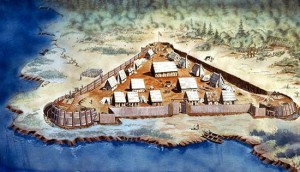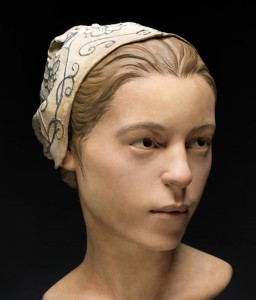In the winter of 1609, life was bleak for residents of Jamestown colony. Of the 400 settlers, only 61 survived to see the end of 1610. The first group of settlers, consisting of about 200 individuals, predominantly male, were unaccustomed to work and untrained in agriculture. The goal of their colony was mainly to find gold, having been informed that their financial support would end should they not produce valuables. Due in large part to their fixation on finding these valuables, they had little luck growing their own food. Harsh winter and exposure to malaria soon decimated their ranks, and by the end of their first year, only 38 of their original group remained. Having failed to plant or store crops, the settlers resorted to stealing food from the nearby Powhatans, souring the relationship between the two groups and effectively ending their only hope of trading for food.
Two supply shipments came during 1608, but neither had sufficient provisions and both carried about 70 people, exacerbating the ongoing famine. The winter of 1609-1610 came to be known as the “Starving Time”, with food so scarce that colonists ate everything that did not eat them first: horses, cats, rats, even shoe leather became fair game as the winter raged on.
Eventually, as the famine showed no sign of abating, thoughts turned to cannibalism. One man was executed for slaughtering his pregnant wife, storing her and salting her flesh. However, although there are many accounts of that crime, prior to the recent discovery of the skeletal remains of a 14-year-old girl, there was no physical evidence that cannibalism had taken place at Jamestown. According to the forensic anthropologist who examined her remains, the girl (whom they named “Jane”) was clearly consumed as a last resort, by someone who had no experience butchering. It is believed that Jane was newly deceased and had been removed from her grave shortly after burial in order to be consumed. Jane’s skull has many tentative cuts in the jaw and forehead, and a large part of the rear of her skull was crushed, likely to remove her brain. These marks are consistent with an inexperienced butcher.
In a case in which the body is removed from the context in which it is buried, much interpretation is required of the archaeologists who examine the site. Jane was found as a disassembled set of bones, her skull and femurs mixed in with the bones of other animals showing signs of consumption. It required the knowledge of archaeological context to connect that cannibalism occurred during the time and place that Jane died, as well as the interpretation of the marks on Jane’s skull. It is thanks to archaeology that scattered remains such as Jane’s are able to be identified and associated with a timeline.
Sources and Additional Information:




The story of Jane is one that challenges us to consider which scenario is the most “acceptable.” If Jane had been killed for food then early Americans were capable of doing anything to survive. If Jane had already died then these people were just doing what was necessary. The claim that she had already been buried before she was dug up for food is one that needs a critical eye. Meat rots very quickly and consuming something (or someone) that had been dead for days would cause illness. Either Jane died when it was so cold that her body was naturally refrigerated or she had to have been eaten soon after her death.
Cannibalism is a taboo subject in the complex history of humans. The reasons for the practice usually stemmed from survival and rituals. It is considered a prehistoric cultural act that is obviously denounced in our modern society. However, when evidence of cannibalism is found, archaeologists have to question the nature of those that committed the act and the possible reasons for it. More importantly, we have to examine the Western lens in which we use to investigate. Acts of cannibalism in various communities cannot be simply deemed as savage and indicative of underdeveloped societies. That is dangerous because it leads to wrongful assumptions about a people and its culture. Archaeologists work to do the opposite.
For more information about cannibalism in an anthropological context, check out this article:
http://science.jrank.org/pages/7538/Cannibalism.html